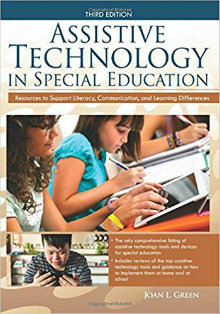Assistive Technology in Special Education
Assistive Technology in Special Education: Resources to Support Literacy, Communication, and Learning Differences, 3rd Edition
By Joan L. Green
(Prufrock Press, 2018 – Learn more)

Understanding the complex and ever-changing world of assistive technology (AT) is a daunting task, especially for the individuals, families, and professionals concerned about maximizing the use of advances in technology to support people with learning differences who may be challenged by communication and literacy needs.
In the revised edition of Assistive Technology in Special Education: Resources to Support Literacy, Communication, and Learning Differences, 3rd Edition, Joan Green helps readers navigate this complex topic with a straightforward, organized approach to understanding and effectively implementing AT.

Meeting communication and literacy needs
Assistive Technology in Special Education focuses on the use of AT for students receiving special educational services; however, there is plenty of practical information in the text that any user of technology will find relevant and useful.
The meaningful use of AT is an important consideration for all personnel working with students with learning differences who may be challenged by communication and literacy needs.
Even as the affordability and availability of educational and personal technology tools increase, there is a risk that people who can most benefit from advances in technology may not have fair and equitable access to the effective use of AT. Therefore, as Green asserts, it is even more imperative that professionals are knowledgeable about the effective use of the varied AT tools to support greater success and independence for all individuals.
As a former special education teacher and now a teacher educator, I agree with Green; I understand the importance of having a reliable source such as this book to gain a deeper understanding of the role of AT in supporting a range of needs. In addition, this book provides an annotated list of tools, software, and apps to address specific needs and anticipated outcomes.
AT: Its terminology and possibilities
After reviewing this book, I recommend reading the first three chapters, all relatively short and reader-friendly, to gain a foundational understanding of AT, familiarity with the terminology used in this field, and an appreciation for the possibilities AT offers individuals.
Chapter 1 offers basic definitions and tips on getting started with AT. In chapter 2, Green gives an overview of the benefits of AT and describes assistive technology features in common devices many people already possess, such as read-aloud and speech-to-text features, enlarged text on screens, and recording capabilities on tablets, laptops, and smartphones. Accessing technology through various methods, such as specialized keyboards, trackballs, and switches, is covered in Chapter 3 with a thorough description of each access method and the considerations for use.
After reading the first three chapters, readers will have a good foundation of AT terminology, the potential benefits, and important considerations in making decisions to support learners. Beyond these introductory chapters, readers can choose to review subsequent chapters that are most relevant to their interests.
Using AT technologies for specific needs
Each chapter is a stand-alone resource on specific AT technologies and commonly used digital devices, software, and apps that may be employed to support a range of needs. Chapter topics include using technology to improve verbal expression, auditory comprehension, receptive language, reading skills and comprehension, written expression and writing skills, executive functioning, and organizational skills. Green devotes other chapters to the relevant topics of digital collaboration, storage, safety, and organization.
Each chapter is organized in a consistent manner beginning with a definition and basic information about the need area, general guidelines to support continued development/learning of target skills, and the benefit and considerations of using AT to support people with this challenge.
Following this introduction, the author gives a candid review of AT tools that are frequently used including each tool’s strengths, drawbacks, cost, and contact/source information. Throughout each chapter there is an emphasis on meeting individual needs in the most efficient way possible and the importance of professional decision-making to match the use of AT with a full understanding of the areas of need. As Green asserts, “…technology does not replace [professional] expertise” (p. xv).
The comprehensive resource I’ve been searching for
I highly recommend this comprehensive yet easy-to-read resource on AT. While technology tools can evolve at a rapid pace, having a core understanding of the potential benefits of digital tools, software, and apps is important for all professionals working to fully support students with learning challenges in communication and literacy.
While the information in this book can be gathered from several other sources, mainly through online searches, I have been on a quest, with limited success, to find one reliable, easy-to-use resource on assistive technology that is comprehensive and offers a curated list of AT tools and devices that can be used for a range of need areas.
My search is over!
Dr. Carol Willard (carol.willard@oswego.edu), a special educator for over 20 years in public schools, currently is an assistant professor at the State University of New York at Oswego. She teaches in both undergraduate and graduate programs preparing teacher candidates, emphasizing the importance of relationship building and collaborative practices to meet the needs of diverse learners.






























